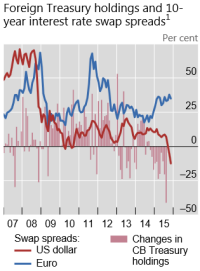Courtesy of Mish.
In it latest quarterly report, the BIS (Bank of International Settlements), pointed a direct finger at Fed chair Janet Yellen with an even bigger point at ECB president Mario Draghi.
Specifically, the BIS cited unthinkably low interest rates, bond market dislocations, and more taper tantrums in its Quarterly Review, December 2015, released today, Uneasy Calm Awaiting Lift-Off.
The BIS is sometimes referred to as the central banker’s bank. Inquiring minds may wish to read the “BIS About Page” for details.
Much of the BIS quarterly report is a recap of the volatility earlier this year when the Fed signaled a potential hike in September then backed off.
Here are a few other highlights:
Recent Dislocations in Fixed Income Derivatives Markets
Recent quarters have witnessed unusual price relationships in fixed income markets. US dollar swap spreads (ie the difference between the rate on the fixed leg of a swap and the corresponding Treasury yield) have turned negative, moving in the opposite direction from euro swap spreads. Given that counterparties in derivatives markets, typically banks, are less creditworthy than the government, swap rates are normally higher than Treasury yields because of the additional risk premium. Hence, the negative spreads point to a possible dislocation.
Tightening in the United States May Challenge EMEs
In August 2015 the VIX had reached levels not seen since the onset of the European debt crisis in 2011 and CDS spreads on EME sovereigns had exceeded levels experienced during the worst of the taper tantrum. [Mish Comment: Is that the real reason for the Fed’s ultra-dovish September statement since unwound? I think so]
There have also been signs that EM local currency yields are increasingly sensitive to developments in the United States. The post-crisis era has been characterised by strong international spillovers from US bond yields to emerging markets, even when those countries were at different stages of the business cycle.
And this effect seems to have strengthened over time. A simple rolling regression of an EME bond index on US 10-year Treasury yields suggests that the potential for spillovers is larger now than it was during the taper tantrum.
Debt service ratios will inevitably increase even further when lending rates start to rise. Any further appreciation of the dollar would additionally test the debt servicing capacity of EME corporates, many of which have borrowed heavily in US dollars in recent years.
“Unthinkably” Low Interest Rates…




